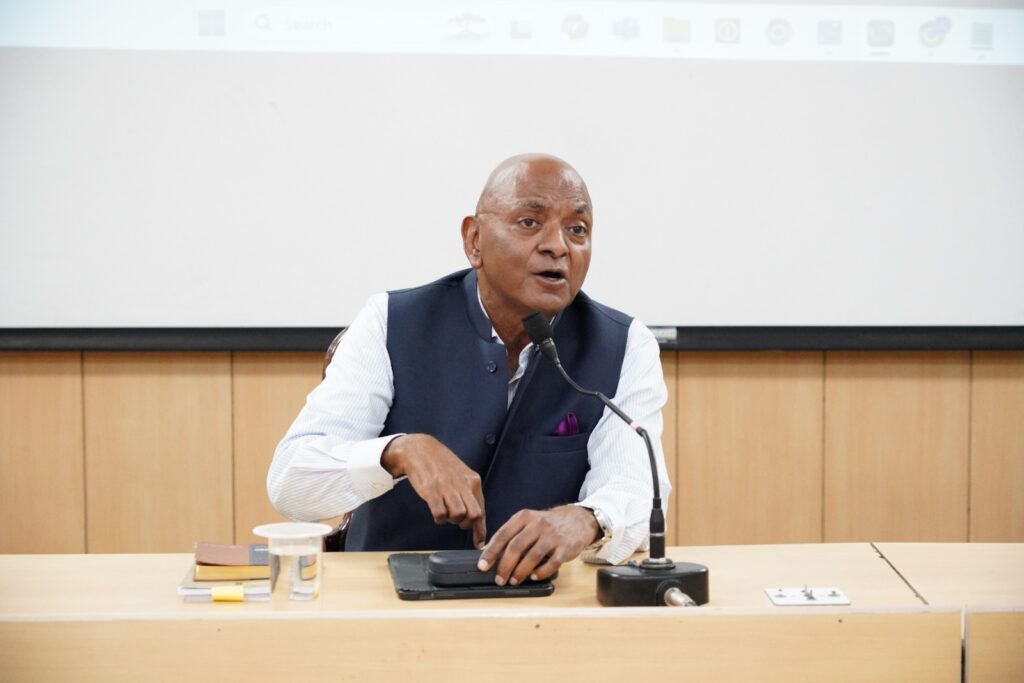From Bench to Accountability: NALSAR Hosts Raju Ramachandran’s Landmark Lecture
(Syed Ali Taher Abedi)
On 26 June 2025, NALSAR University of Law hosted a thought-provoking lecture by Mr. Raju Ramachandran, Senior Advocate at the Supreme Court of India and Distinguished Professor of Law at NALSAR. The lecture, focusing on the critical subject of the removal of judges, was part of the University’s ongoing Distinguished Lecture Series.
Event Commences with Esteemed Introductions The session began with Prof. Anup Surendranath introducing Mr. Ramachandran, followed by Dr. Malvika Prasad providing a brief overview of the objectives and vision of the Lecture Series.
Distinguished Attendees and Engaged Audience The event was graced by the presence of Prof. (Dr.) Srikrishna Deva Rao, Vice-Chancellor of NALSAR University of Law, Prof. N. Vasanthi, Registrar, and Prof. Sitharamam Kakarala. It drew an enthusiastic audience comprising students, faculty members, and professionals from the legal community.
In his address titled “Removal of Judges: From Justice V. Ramaswami to Justice Yashwant Verma”. Mr. Ramachandran drew from historical instances, key legal developments, and his own experience as a member of the Inquiry Committee in the Justice V. Ramaswami case, the first and only full-fledged judicial impeachment proceeding in India.

Mr. Ramachandran began by outlining the evolution of judicial tenure protections, beginning with colonial frameworks and moving to the post-Independence constitutional safeguards designed to uphold judicial independence. He noted the anomaly presented in the 1964 case of Justice Jaffer Imam, who, suffering from mental incapacity, had to be persuaded by Prime Minister Nehru to resign in the absence of a removal procedure for incapacity short of impeachment.
The lecture focused extensively on the Justice V. Ramaswami case and he recounted the procedural integrity of the inquiry and the political failure of the impeachment motion, which was defeated in Parliament due to abstentions by the ruling party despite the committee’s adverse findings.
Highlighting the limitations of the current constitutional and statutory framework, Mr. Ramachandran critiqued the over-reliance on the in-house mechanism, a non-statutory process evolved by the judiciary to deal with allegations of misconduct. He noted that this mechanism lacks transparency, operates outside public scrutiny, and creates constitutional uncertainty when its findings influence or precede impeachment motions in Parliament.
While reflecting on recent developments, Mr. Ramachandran spotlighted the case of Justice Yashwant Varma, in which an internal committee had recommended impeachment. He expressed concern over the legal ramifications of such findings being contested before the judiciary, and questioned how the coexistence of judicial review and parliamentary impeachment proceedings could lead to institutional conflict. He warned that this dual-track approach might erode the integrity of both mechanisms, potentially culminating in what he described as a “reverse-Ramaswami scenario.”
Mr. Ramachandran concluded by underscoring the need for a comprehensive, constitutionally anchored mechanism that balances the independence of the judiciary with genuine institutional accountability. He emphasised the importance of transparency, procedural fairness, and consistency in safeguarding both public confidence and constitutional integrity.



